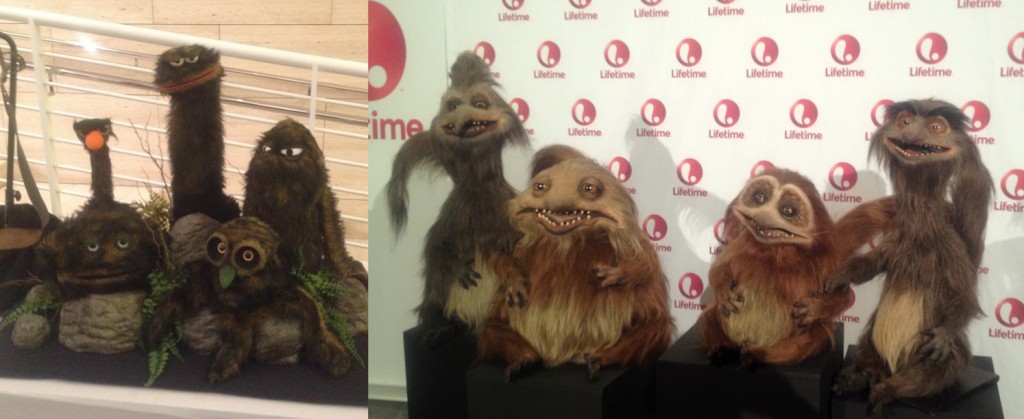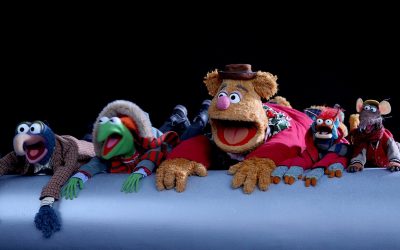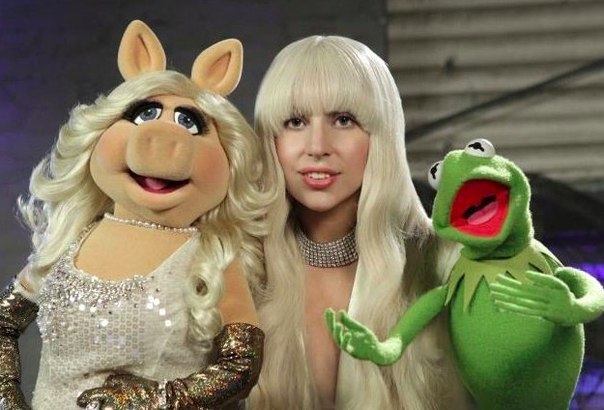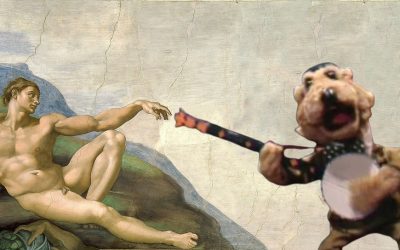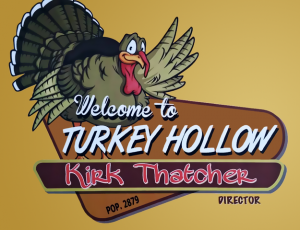 Last week, in preparation for the premiere of Jim Henson’s Turkey Hollow (which airs on November 21st on the Lifetime network), your pals at ToughPigs HQ were invited to participate in two press events. Because we’re members of the press. And yes, it’s very weird to think of ourselves that way.
Last week, in preparation for the premiere of Jim Henson’s Turkey Hollow (which airs on November 21st on the Lifetime network), your pals at ToughPigs HQ were invited to participate in two press events. Because we’re members of the press. And yes, it’s very weird to think of ourselves that way.
In Los Angeles, we were invited to an advanced screening of the film at the Paley Center for Media, which was followed by a panel discussion led by Stephen Christy, Editor-in-Chief of Archaia Entertainment. The panel included Director Kirk Thatcher, Executive Producer Lisa Henson, and actors Mary Steenburgen and Jay Harrington.
In New York, we participated in a phone Q&A with Kirk Thatcher and Lisa Henson, specifically for the Muppet fan sites. (Other press agents included JD Hansel from Muppet Hub and Mitchell Stein of the Muppet Mindset, and you can read their coverage at the links provided. It was a total nerdfest.)
Because there was a lot of overlap in the info and stories we heard, we’re mixing our coverage of the two events together. Think of this as your behind-the-scenes look at a film that you probably haven’t seen yet. Anyway, here’s what we learned:
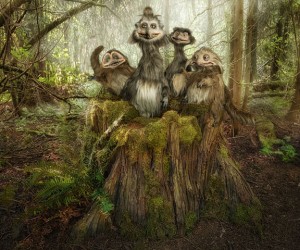 When Lisa Henson and Stephen Christy were looking for projects to adapt into graphic novel form for Archaia, they went with Karen Falk into the Henson Company archives and found many things, such as “Tale of Sand” and “The Musical Monsters of Turkey Hollow”. Christy and Lisa Henson came upon Turkey Hollow at the same time, and Christy immediately wanted to make it as a graphic novel, while Henson wanted to turn it into a TV production. Since Turkey Hollow was only a treatment and not a full script (as Tale of Sand was), they decided that there was room for two different adaptations of the work, and now the world is now graced with two separate but both amazing versions of Turkey Hollow.
When Lisa Henson and Stephen Christy were looking for projects to adapt into graphic novel form for Archaia, they went with Karen Falk into the Henson Company archives and found many things, such as “Tale of Sand” and “The Musical Monsters of Turkey Hollow”. Christy and Lisa Henson came upon Turkey Hollow at the same time, and Christy immediately wanted to make it as a graphic novel, while Henson wanted to turn it into a TV production. Since Turkey Hollow was only a treatment and not a full script (as Tale of Sand was), they decided that there was room for two different adaptations of the work, and now the world is now graced with two separate but both amazing versions of Turkey Hollow.
A few months later, they found the actual original puppets that Jim Henson built in storage in the “throw-away pile”, which was where old puppets went to be disposed of after they were deemed unusable. The fur was in tact, but the insides had disintegrated into dust. Lisa Henson recognized them as the puppets she and her sister Cheryl helped photograph with their father, and was able to rescue them and have them restored. Now they’re a part of Henson history and among the rest of the display puppets used for things like the museum exhibits.
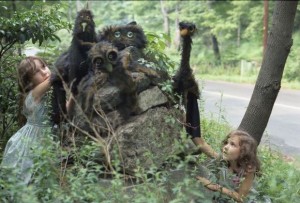 Lisa vividly remembers taking the old photographs of the original Turkey Hollow Monsters with her sister because she said that Jim never brought puppets home, so it was a real treat. Jim wanted to prove that the puppets would look good in the outdoors in natural light in the woods. Don Sahlin built the puppets to look like creatures that would actually crawl out of the woods. They were also experimenting with the eyes – until that point, all of the Muppet characters had googly eyes or painted-on eyes, and this was the first time they attempted the glass taxidermy-style eyes for their characters (which makes them predecessors to the Gorch characters and the Dark Crystal puppets). Jim and Don painted on the back of the glass themselves. The new puppets are inspired by the shapes and styles of the original puppets, but scaled much larger. The eyes, like their predecessors, are hand painted.
Lisa vividly remembers taking the old photographs of the original Turkey Hollow Monsters with her sister because she said that Jim never brought puppets home, so it was a real treat. Jim wanted to prove that the puppets would look good in the outdoors in natural light in the woods. Don Sahlin built the puppets to look like creatures that would actually crawl out of the woods. They were also experimenting with the eyes – until that point, all of the Muppet characters had googly eyes or painted-on eyes, and this was the first time they attempted the glass taxidermy-style eyes for their characters (which makes them predecessors to the Gorch characters and the Dark Crystal puppets). Jim and Don painted on the back of the glass themselves. The new puppets are inspired by the shapes and styles of the original puppets, but scaled much larger. The eyes, like their predecessors, are hand painted.
Kirk Thatcher tells us that he’s really happy with the final product. A lot of the time, a director will say that the project is good but didn’t exactly match up to their vision due to things beyond their control, but Turkey Hollow is about 90% of what he wanted it to be.
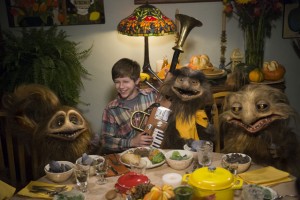 He also gives credit to Pete Brooke at the Jim Henson Creature Shop for redesigning the puppets and updating them for the movie. They didn’t want the characters to look like “puppets,” they wanted them to look like real creatures. They aimed for the idea that if you saw them in a zoo, you’d say, “Wow, that’s a weird-looking animal,” but you’d believe that it’s a real creature and not a Muppet. Kirk describes them as a mix between a badger and a raccoon, in that they can be very scary, but also adorable. He also used the word “fugly” several times, which is equal parts adorable and disgusting.
He also gives credit to Pete Brooke at the Jim Henson Creature Shop for redesigning the puppets and updating them for the movie. They didn’t want the characters to look like “puppets,” they wanted them to look like real creatures. They aimed for the idea that if you saw them in a zoo, you’d say, “Wow, that’s a weird-looking animal,” but you’d believe that it’s a real creature and not a Muppet. Kirk describes them as a mix between a badger and a raccoon, in that they can be very scary, but also adorable. He also used the word “fugly” several times, which is equal parts adorable and disgusting.
But there’s no point in having cool puppets if you don’t have great puppeteers! The first and only LA-based puppeteer they hired was Alice Dinnean. In addition to performing “Squonk”, she also served as the Puppet Captain, marking the first time that a female puppeteer filled this role for the Jim Henson Company. Super congratulations on that, Alice!
The rest of the puppeteers were hired in Canada (where the film was shot). Fraggle Rock performers Gord Robertson and Rob Mills (who performed the bodies of Pa and Junior Gorg, respectively) were brought on. According to Kirk, the duo fill a complete array by being opposites: Gord is a small, polite man with a light voice; Rob is large with a deep voice and a crude sense of humor. Gord performs “Thrinng,” while Rob performs “Burble.” The fourth main performer is Jason Hopley, who had never worked with Henson before. Hopley is a very successful puppeteer and showrunner of Canadian productions who the Hensons had always wanted to work with. Hopley performs “Zorp.”
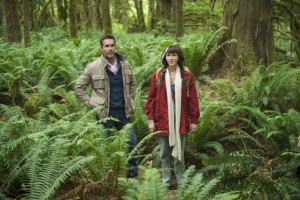 Of the 18-day shoot, 12 of those days were spent outdoors in the forest. This meant that the puppeteers found themselves lying in the dirt for almost two weeks. The performers had one week to familiarize themselves with the characters and synchronize with the other puppeteers, which was important because at times there were three performers per character – one for the face, one for the eyes, and one for the tail.
Of the 18-day shoot, 12 of those days were spent outdoors in the forest. This meant that the puppeteers found themselves lying in the dirt for almost two weeks. The performers had one week to familiarize themselves with the characters and synchronize with the other puppeteers, which was important because at times there were three performers per character – one for the face, one for the eyes, and one for the tail.
Speaking of those tails, they’re included in one of the more impressive, yet simple puppetry tricks. Rather than try to find a way to show the full bodies of the monsters scurrying down the forest, they just attached the tails to radio-controlled cars and set them loose through the brush. According to Kirk, Jim loved these kinds of puppetry tricks.
The best “trick”, however, was how they hid the puppeteers in the wooded setting. Just as Jim figured out how to hide himself during the “Rainbow Connection” shoot by submerging himself in the swamp water, Kirk Thatcher knew that the simplest solution is often the best. Six puppeteers were buried alive for 45 minutes. They sat in a ditch, which was then covered with planks, dirt, and cloth coverings to hide them from the scene. That is insane and amazing, and most likely completely worth it.
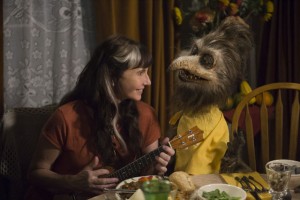 At one point in the script development, the idea to set the movie in the 1960’s was explored. The idea would be that not only was the script discovered, but so was the entire movie. This idea was eventually scrapped and the movie was set in the modern day.
At one point in the script development, the idea to set the movie in the 1960’s was explored. The idea would be that not only was the script discovered, but so was the entire movie. This idea was eventually scrapped and the movie was set in the modern day.
Lisa Henson saw a lot of her mother, Jane, in the film. Mary Steenburgen played Aunt Cly with some Jane-like affectations, and some of the set decoration of her house reminded Lisa of her mother’s home. Even some of the items on the set were almost identical to some of Jane’s possessions.
Mary Steenburgen’s character Aunt Cly’s house was a mess. The house had mold in it at some point, the lingering scent of old cats was in the air, the basement had to swept clean of rat droppings, and Steenburgen’s allergies bothered her most of the time she was there. But in the end, the set design team turned it into a beautifully wacky home with so much kitsch and warmth.
While on set, there was one turkey being rented out that bit child actor Graham Verchere on the nose. It didn’t end up doing serious damage but it was scary enough for everyone on set. So when the kids are talking in the movie about whether or not a turkey will bite them, that came from a very real place.
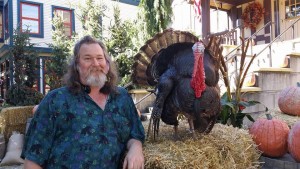 Kirk Thatcher’s very brief cameo came as a surprise even to Kirk. When they were looking through headshots of actors to play Uncle Ned, Lisa said, “We need someone who looks like Kirk. Hey! Why don’t we get Kirk!”
Kirk Thatcher’s very brief cameo came as a surprise even to Kirk. When they were looking through headshots of actors to play Uncle Ned, Lisa said, “We need someone who looks like Kirk. Hey! Why don’t we get Kirk!”
One person’s name I was surprised to find on the archival notes was Joe Raposo. Henson had spoken with Raposo about providing music for the special, which would have been quite a treat given his work on Hey Cinderella!, The Frog Prince, and of course Sesame Street. When asked if any of the music Raposo wrote was found in the archives, Lisa told us that it had never gotten to the song-writing stage. In fact, all of the notes for Turkey Hollow amounted to 14 pages. That was all there was to the special, and collaborators over the years have helped fleshed it out into what we have today.
The other musical aspect would have been provided by Raymond Scott. Jim had a Moog synthesizer that he loved and he wanted to use electronic music to create the sounds of the musical monsters, long before auto-tuning and electronic music became as popular as it is today.
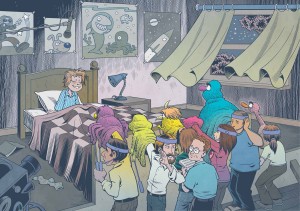 The question of “What would Jim have done?” never came up on set – instead they asked “Would Jim like this?” Although Jim loved the collaborative process, he preferred to invest in creative people and trust them to continue the process. One of those people, of course, was Kirk Thatcher, so we always knew that Turkey Hollow was in good hands. But that didn’t stop him from seeing in inspiration from his former colleagues by noting, “This is a very Jim thing, this is a Jerry thing, or this is even a Jane thing,” as evidenced by Aunt Cly’s house.
The question of “What would Jim have done?” never came up on set – instead they asked “Would Jim like this?” Although Jim loved the collaborative process, he preferred to invest in creative people and trust them to continue the process. One of those people, of course, was Kirk Thatcher, so we always knew that Turkey Hollow was in good hands. But that didn’t stop him from seeing in inspiration from his former colleagues by noting, “This is a very Jim thing, this is a Jerry thing, or this is even a Jane thing,” as evidenced by Aunt Cly’s house.
Still, Kirk felt like he was “working with the guys again”. He worked closely with Jerry (especially on writing Muppet Treasure Island) and remembered his advice, “Make it funny, but never lose the heart and the relationships of the characters.” They really felt as if Jim and Jerry’s spirits were with them as they made the film.
And in what I hope doesn’t come as a surprise, absolutely everyone wants to do a sequel. So make sure you tune in, watch one of the endless reruns Lifetime Channel loves to talk about, and let’s cross our fingers for what we’re dubbing Turkey Hollow II: Back to the Hollow!
Click here to bury yourself neck-deep on the ToughPigs.com
by Joe Hennes and Matt Wilkie

